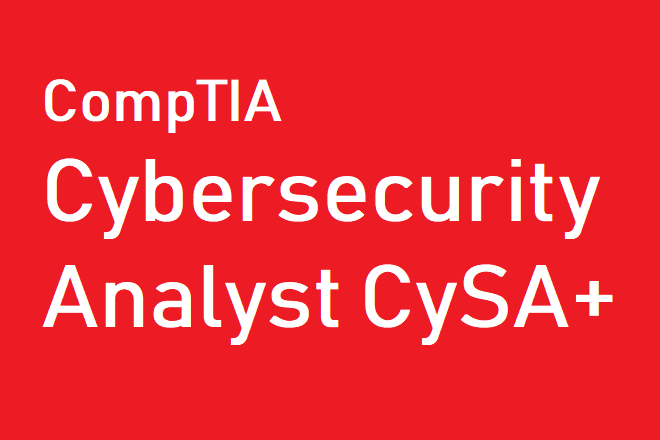CompTIA has been the pioneer and the leading of IT certifications in the market. Having successfully built a reputation of high caliber certifications which have an acceptability around the world, CompTIA has been expanding and utilizing its resources to deliver more of the highly demanded IT qualifications employers require. One such of these certifications is a Cybersecurity Analyst certification, which deals with behavioral analytics to networks and devices in order to prevent, identify and counter cybersecurity threats.
The CompTIA certification examination enables applicants to utilize threat-detection tools in addition to protect and secure applications and systems within an organization. The examination would also assist in the preparation of a report on security architecture consisting of various suggestions on improvements in the security environment.
In this article, we will be taking a deep look in how to prepare for the CompTIA CyberSecurity analyst cysa+ certification’s examination and go through the detailed content of the examination.
Recommended Experience
This examination is considered ideal for experienced professionals who have spent about 3 to 4 years in the field in context to networking terminologies and functions such as Ethernet, OSI Model, Wifi and are also aware of the TCP/IP addressing, core protocols and troubleshooting tools.
Along with the knowledge of various technologies and standards pertaining to networks and their security, applicants should also have the strategic mind and experience of implementing them for threat protection purposes. This recommended experience goes a long way in ensuring that the applicants quickly grasps the new and challenging concepts of Cybersecurity which would be tested in the examination.
Examination Content
Threat Management
Threat management is one of the primary aspects of the CompTIA certification’s examination, as it revolves around critical elements like Cybersecurity analysis, reconnaissance techniques, security appliances and logging.
In the cybersecurity analysis, examinees must know the various roles and responsibilities associated with cybersecurity, along with understanding the frameworks and security controls. This is followed with risk evaluation and penetration-testing processes that are useful in assessing whether the standards and controls implemented would end up paying dividends or would falter to any incoming threat.
In the reconnaissance techniques, examiners expect the applicants to have a comprehensive understanding of both the theoretical and practical aspects of the kill chain, open-source intelligence, OS fingerprinting, topology discovery and social engineering.
Moving on, the other aspect of threat management involves utilizing the various appliances to configure firewalls, configure IDS, detect and protect intrusion, setup anti-virus software, work through malware threats and also boost the mitigation experience toolkit.
Finally, in the preparation for the examination, applicants should also make sure to go through packet capture, SIEM data outputs and analysis and use the monitoring tools and do point-in-time data analysis. All of these measures ensure the effective threat management of the security architecture of a system and network, which play a major hand in it’s the smooth operations.
Vulnerability management
Moving on the vulnerability management aspect of the CompTIA cybersecurity analyst certification deals with managing and remediating vulnerabilities and ensuring a secure software development.
The applicants for the examination should be well familiar will data classification, vulnerability management process, vulnerability scanners, vulnerability feeds, DCAP and scans. This is followed by the remediation of various elements like host and network vulnerabilities, and virtual infrastructure. Additionally, while developing software, the examinees would be expected to have a comprehensive grip on the development life cycle, security testing, interception proxies and web application firewalls.
Reverse engineering and source authenticity are yet more of the essential elements linked to vulnerability management and perfecting executing this aspect goes on to really give an edge to a cybersecurity analyst in perfecting their job and standing out from the competition.
Cyber Incident Response
Being a Cybersecurity analyst, it is essential to know how to respond to cyber incidents. Hence, a big chunk of the examination deals with the incident response, which includes the numerous processes, classifying threats, recognizing the severity and critical nature of an incident.
These procedures lay down the foundation work for dealing with any cyber incident, after which forensic tools are utilized to further inspect the threats and incidents. The forensic tools too are extensively covered in the examination, which consist of image acquisition, password cracking, analysis utilities, digital forensics kits and crime scenes. After this comes the most important phase of incident response aspect which is the analysis and recovery.
The examination therefore tests several elements pertaining to this, such as analysis linked with recovery frameworks, network symptoms, host symptoms, data exfiltration and application symptoms.
There are additional techniques employed too relating to containment, eradication and validation and finally corrective actions are taken place. The CompTIA cybersecurity analyst CySa+ certification examination is a tough one, and properly prepping for this aspect of the examination is a must-do for any applicant.
Security Architecture
Last but not the least is the security architecture component of the examination. This component teaches and exposes applicants to some of the highly demanded skills in the market such as designing a secure network, managing identities and implementing security frameworks and policies.
Digging deeper into this component shows that several of the essential cybersecurity elements are covered in it, for instance network segmentation, system hardening, endpoint security and network access control to name a few. This is followed by exploiting identities and web browsers, ensuring context based authentication, identity management and security, and also working around blackholes, sinkholes and honeypots.
This is not all as personnel policies and training, verification and quality controls and security policies, procedures and controls are also covered in the last segment of the component. All in all it helps applicants of the CompTIA certification to really comprehensively understand every single thing of which there is a possibility of being tested in the examination.
So, this was a detailed walkthrough of the major components of the CompTIA Cybersecurity Analyst certification’s examination. If there was any examination you had to get right, it should be this one as the certification then vastly opens new career and career growth opportunities which every IT specialist dreams about.













